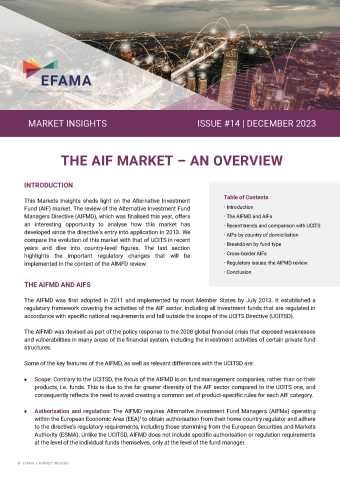EFAMA has released today a new issue of its Market Insights (MI) series titled “The AIF market – an overview”.
This publication sheds light on the Alternative Investment Fund (AIF) market in Europe, comparing its recent evolution with that of UCITS and diving into country-level figures. It also highlights the important regulatory changes that will be implemented in the context of the AIMFD review.
- Net assets of AIFs reached EUR 7.26 trillion at the end of the first half (H1) of 2023. Total AIF asset growth since end 2015 amounted to 41%.
- Compared to UCITS, both net asset growth and net sales of AIFs fluctuate less. This is explained by the closed-ended structure of many AIFs and the fact that AIFs invest a smaller portion of their assets in listed stocks than UCITS. AIF investors, mainly insurers and pension funds, also tend to hold their investments for the long term, resulting in fewer significant redemptions during periods of market stress.
- The five largest domiciles in the AIF market at end H1 were Germany, with a 29% market share, followed by France (18.4%), Luxembourg (13.3%), Ireland (11.6%) and the Netherlands (10%). Since end 2015, the AIF market has become slightly more concentrated, with the market share of the top 5 domiciles shifting from less than 80% to more than 82% at the end of H1 2023.
- Broken down by overall investment strategy, real estate funds and in particular ‘other’ AIFs saw their market share increase in recent years. Other AIFs encompass a wide range of fund types, including private equity funds and hedge funds. What these funds have in common is that they mostly invest in alternative and often less-liquid assets. Real estate and alternative assets were significantly less impacted by the 2022 decline in capital markets.
- Cross-border AIFs have been gradually growing in importance: between 2015 and the end of H1 2023, their market share increased from 22.4% of the total AIF market to 28.5%. Compared to the UCITS market, however, the AIF market is still very much focused on home-domiciled funds.
- The AIFMD review has been completed, bringing improvements to an already well-functioning framework while preserving its essential features.
- The delegation regime remains largely unchanged, with increased transparency via additional reporting upon authorisation and periodically.
- Another important achievement is the inclusion of a wide range of liquidity management tools, combined with a clear recognition of the manager’s primary responsibility when choosing and implementing these.
- New rules were also introduced, allowing for an appointment of a depositary domiciled in a jurisdiction other than that of the fund, which is a preferable solution to a fully-fledged depositary passport.
- Provisions governing loan origination, despite them being product-specific, were also included with the aim to create an efficient internal market for such funds.
Thomas Tilley, Senior Economist at EFAMA, commented: “The solid growth of AIF assets under management since 2015 suggests that, overall, the AIFMD is functioning well. AIFs clearly have a place, next to UCITS, in delivering returns to investors and providing financing to the economy. The growing importance of cross-border AIFs in particular is encouraging, as it is an indication that the deepening of the single European capital market is progressing.”
Zuzanna Bogusz, Regulatory Policy Adviser at EFAMA commented: “The review kept intact the foundations of the AIFMD framework, which created the AIF market as we see it today, with an important one being the delegation regime. The introduction of a wide range of liquidity management tools is an improvement, as it gives managers an expanded toolkit to address liquidity risk. We will monitor how the market reacts to some other elements, like those on depositaries and loan origination, where we had some concerns.”
EFAMA’s Director General, Tanguy van de Werve commented: “Looking to the future, we are convinced that AIFs can play a growing role in financing Europe’s sustainable transition. The long-term investment horizon of many institutional AIF investors, and the type of assets AIFs invest in, make them ideally suited for this purpose.”
- ENDS -
Notes to Editors
For further information, please contact:
Hayley McEwen
Head of communications and member development
About the Market Insights
EFAMA’s Market Insights series analyses recent industry trends and developments based on the latest available data and presents our findings in the context of current policy perspectives. We publish numerous concise reports each year covering diverse topics such as ETFs, SFDR, the impact of inflation on retail investors, sustainable bond funds, UCITS costs and performance, ESG fund markets, and money market funds.


























